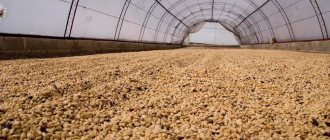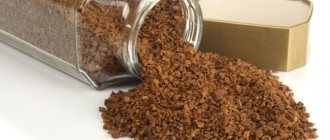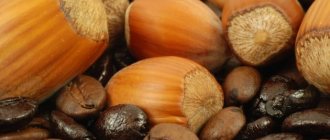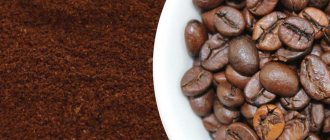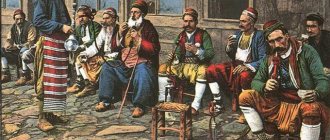Currently, the word “coffee” refers to a drink, most often hot, obtained by brewing crushed coffee beans. Literally translated from Arabic, the name coffee sounds like an stimulating drink .
Indeed, after drinking the drink, a strong stimulating and stimulating effect is felt, due to the caffeine content in it.
Today, the real magic of this drink with its enchanting aroma can be discovered by visiting Italy. After all, it was there that coffee turned into a part of the national cuisine, inseparable from pizza, pasta and olive oil. When you come to Italy, you can try at least one of the many varieties of coffee served in Italian bars. And having tried this rich, strong drink in its pure form or with the addition of milk foam, ice cream, liqueur or lemon, you will rediscover all the facets of its taste .
Origin
Probably no one will be able to say for sure when and by whom coffee was discovered. One version of the origin of coffee takes us back to 900 BC.
It was then, according to legend, that one of the Ethiopian shepherds noticed the very active behavior of goats after eating red berries on one of the trees. After tasting these berries, the shepherd felt his body filling with strength and energy.
It was in this area of Ethiopia, called Kaffa, that the coffee tree and coffee, the drink obtained from it, found their name.
Since then, they have tried to process the fruits of the coffee tree in a variety of ways. The grains were dried, boiled, crushed, and made into a tincture. And all this for the sake of the tonic effect of coffee beans. Over time, the Ethiopian lands were occupied by the Arabs, and the habit of consuming the tonic product took root among the new residents. They ground raw grains, mixed them with fat and made balls that were very convenient to take on the road. Raw coffee beans are small nuts that contain caffeine. Therefore, the resulting ground product could both feed and invigorate travelers during long journeys.
It wasn't until many centuries later that experiments with coffee beans came down to initial purification, followed by roasting and grinding to further brew the resulting powder.
The resulting aromatic drink could not compare to the initial attempts to consume coffee beans. Historians say that coffee seeds were first roasted in Yemen in the 11th century AD. In addition, the Arabs began to add cinnamon, ginger and other spices to the coffee drink when brewing.
By the mid-15th century, coffee reached Turkey. The easterners liked it so much that the church ministers had to curse the coffee with the name of the prophet. After all, they saw that believers began to spend much more time in coffee shops than in prayer. However, over time, the church's dislike of coffee faded.
Along with the widespread use of coffee, the art of preparing this drink also appeared. Places where coffee was prepared in public began to appear everywhere. Coffee shops became places for meetings, and coffee served as a reason for pleasant friendly communication. The image of coffee shops gradually moved to Europe over time. And their inner world is reflected in modern cafes.
Coffee came to us from Turkey. However, the bitter drink could not take root in Rus' in the Middle Ages. However, in the 18th century, Peter I began to insist on drinking coffee, believing that it promoted mental agility. And after 1812, drinking coffee in Russia began to be considered a sign of good manners.
You didn't know this
Illi, Trombeta, Lavazza, Cartapani - all these are the names of Italian factories that roast coffee beans. Their peculiarity is that each has its own list of coffees offered for purchase. To order and drink coffee correctly, you need to strictly follow established traditions, as well as have a good understanding of the different varieties of this drink.
Only then will you be able to truly enjoy them. So, if you want not just to drink a cup of coffee, but to taste the result of the labors of those for whom preparing it is a real art, welcome to Italy!
History of espresso
Recently, going to a cafe and drinking coffee has become fashionable, and such a way of life has appeared. Invite friends not to your home, but to a cafe for a cup of coffee. When ordering a classic espresso, we don’t even think that this brewing method was invented in Italy, and then widely spread throughout the world. And today, residents of America and Europe, as well as the Middle East and Asia, prefer this type of coffee.
The first espresso machine was introduced in Italy in 1905. The principle of its operation was based on passing water, condensed from steam, under pressure through ground coffee. The taste of the resulting coffee was radically different from the modern drink. Due to severe overheating, the coffee acquired a burnt taste. The main consumers of this coffee were the bourgeoisie, and a little later the preparation method spread to Germany and France.
The mid-20th century saw a major change in the approach to coffee making. Steam has been removed from the espresso machine. Instead, the water was heated to no more than 92 degrees and forced under high pressure through the coffee. It was then that the taste of espresso that we know today appeared. Gradually, the machines were improved, and now espresso is made very quickly and with precise temperature control.
Coffee with alcohol:
✅ Caffè corretto literally translates as “correct coffee.” This means that a couple of drops of strong alcohol – sambuca or grappa – have been added to the espresso.
✅ Ammazzacaffè , or “killer coffee,” is a glass of alcohol (usually sambuca, grappa or bitter amaro liqueur) drunk after espresso and a hearty Italian meal.
Other related articles:
- The history of pizza: how the edible symbol of Italy appeared
- Roman pizza VS Neapolitan. Which one tastes better?
- How to choose a pizzeria in Italy that serves delicious pizza
- 7 Famous Italian Dishes You Should Know More About
- Aperitif and digestif: what is the difference and how do Italians drink?
Quests in Italy
Excursions in Italy
Master classes with Italians
Transfers in Italy
Types of coffee trees
There are about 200 varieties of coffee trees in the world. Of these, only 20% is used by humans. And only 2 main ones are of interest to coffee connoisseurs. Arabica coffee (Coffea Arabica), called Arabian, and Robusta coffee (Coffea Canephora), called Congolese. 90% of coffee consumed comes from the fruits of these particular tree species.
Arabica
The Arabian coffee tree is considered the most popular type of coffee tree. 70% of the world's coffee is produced from its fruits.
The natural height of this tree reaches 6-8 meters, but for ease of harvesting, it is not allowed to grow more than 4 meters.
Arabica fruits are red in color and turn purple when ripe. The length of the fruit can reach 15 mm. The plant is very capricious to climatic conditions and sensitive to diseases and pests. Over the course of a year, one tree produces about 5 kg of fruit, which produces up to 1 kg of finished coffee beans.
Arabica fruits contain 18% aromatic oils and about 1.5% caffeine. The taste of Arabica in the finished drink is sweetish with a slight sourness. The best varieties of Arabica are Bourbon, Maragogipe and Typica.
Robusta
The height of the Canephora or simply Robusta coffee tree in nature can reach 10 meters. But during mass cultivation, it is pruned and shaped into small trees. Robusta flowers are pale pink, and the fruits are greenish or brownish-grayish.
This tree was first discovered in the Congo River Basin in Africa. Today, Robusta trees are grown in both Africa and Asia, mainly on lowland plantations. The plant is quite unpretentious in care. It tolerates temperature changes well and is resistant to diseases and pests. Up to 15 harvests can be harvested from a Robusta coffee plantation per year. It is precisely because of its unpretentiousness and high yield that it is very profitable to grow Robusta.
Robusta fruits contain 8% aromatic oils and up to 3.5% caffeine. The taste of this type of coffee is very specific and quite strong. Because of this, it is most often used to add strength to coffee blends. The taste of Robusta also improves during the production of instant coffee. Despite its lower taste compared to Arabica, Robusta makes up 30% of all coffee produced.
Arabica and Robusta, in turn, are divided into many varieties depending on the region of origin. All varieties differ from each other in both taste and aromatic properties.
In addition to varieties, there is also a coffee classification based on the quality of the beans obtained. For example, SHG is coffee from mountainous areas, HG is coffee from foothills, MG or CS is coffee from lowland plantations; HB – hard bean coffee; A – best quality coffee, B – average quality coffee, C – low quality coffee, AA – best, AB – good, BA – average, BB – low quality.
Roasting nuances
Italian coffee is unique due to its unique heat treatment method. The beans are roasted at a maximum temperature of 245 °C, which gives them bitter-sweet notes without sourness. Each region has its own way of processing coffee:
- Residents of the sultry South know a lot about amazing taste - this is where they practice the highest degree of roasting. Under the influence of temperature, caramelization of the grains occurs, which acquire an almost black color and a pleasant rich aroma. Essential oils evaporate, revealing other shades of the flavor palette.
- The central regions of Italy are characterized by moderation in coffee processing - medium roasting. The grains turn dark brown with oil droplets on the surface, which give the finished drink a sweetish note and a soft burnt flavor.
- In the North of Italy they prefer to make minimal changes to the natural properties of coffee. The color of the beans is beautiful chocolate or terracotta, the beans completely retain all shades of taste. There is practically no bitterness, the sourness characteristic of light roasting is present.
The longer the heat treatment continues, the more intense the flavor is revealed. Sour notes are removed, bitterness appears more clearly. It is important at this stage to maintain the perfect balance - and the Italians are great masters in this matter.
- More on the topic: Types of roasting coffee beans
Culture of preparation and consumption
In Italy they love coffee so much and drink it so much that they have come up with many ways to prepare it. Italians make coffee for breakfast, together with or instead of smoke breaks and, of course, after meals along with dessert.
The classic type of coffee, also called “normale” (from “normale” - ordinary), is considered espresso. What is served in Russia and the countries of the former Soviet Union as espresso is most often very different from its Italian counterpart.
Italian espresso is a velvety dense foam with a golden tint that covers the entire surface of the coffee in the cup, a soft aroma that fills the entire room and makes you forget about everything. The perfect, balanced, pronounced taste of real Italian espresso cannot be described in words.
According to the rules of coffee etiquette, espresso is served in a porcelain cup with thick walls shaped like a truncated ellipse. The standard volume of such a cup is 75 ml, but the contents, depending on the type of coffee, should take from 25 to 50 ml. This serving maximizes the taste and aroma of coffee. In bars, coffee is brewed by a special specialist called a barista.
Learning to order coffee in Italian
Do you want to order coffee in a cafe, but lack the skills to communicate in the local language? No problem! You only need to say a couple of simple phrases:
- To place an order for Italian coffee (in this situation - espresso), just say: “un cafe, per favor.”
- If you need to take more than one cup at a time, UN is replaced by due, tre, quattro, and so on.
- If you want to take coffee with lactose-free or soy milk, just say: “(Name) + “con” + “latte di soya” or alternatively “con latte senza lattosio”.
- At the end, it is pronounced: “gracie”, that is, “Thank you”), and then added: “buòna djornata” (wishes of a good day).
- In order for the bill to be brought, the phrase “posso pagare” or “il conto, per favor” is pronounced, and then everything that was ordered is listed at the checkout.
By the way! In a number of coffee shops, you must first pay at the checkout and then take your order. Then you need to list everything you want to order, pay, and then go to the bar with the receipt.
Everyone likes politeness, and in the Italian state, in general, it is an inseparable part of the local mentality!
Kinds
The most popular type of coffee is, of course, espresso
.
Its smaller version, ristretto
, is a standard portion of ground coffee, but in the amount of 1 sip, i.e. 20 ml. This coffee contains more aroma and less caffeine compared to its classic counterpart.
Watch a video about 10 types of coffee drinks popular in Italy:
Lungo
Lungo
- This is espresso diluted with hot water to double the volume. This coffee contains more caffeine due to the longer passage of water through the ground coffee.
Cappuccino
Cappuccino is espresso with a large amount of milk foam reaching the edge of the cup.
The airy foam is sprinkled with cocoa powder or grated chocolate on top. Professional baristas use milk and chocolate to create a design on its surface. In Italy it is customary to drink coffee with milk before lunch time, i.e. until 11 o'clock. For example, a typical first breakfast is a cup of aromatic cappuccino, a croissant and freshly squeezed orange juice. Cappuccino is served in a preheated porcelain cup.
Americano
Americano
– This is a full teapot of coffee (up to 470 ml), prepared with one serving of ground coffee. The Italians call this coffee aqua sporca, which means dirty water. The truly American brewing method uses a filter coffee maker. In Europe, Americano brewing has undergone changes, and classic espresso is simply diluted with hot water to a volume of 120 ml.
Latte
Latte
– one of the options for coffee with milk. Practically, it is milk with the addition of milk foam, diluted with a small amount of coffee. Moreover, the coffee is poured into the heated milk in a very thin stream, and not vice versa. Served in a tall transparent glass of 200 ml.
Mocha or Mochaccino
Mocha or Mochaccino
This is a type of latte coffee. In this case, one-third of the drink is espresso, and the remaining two-thirds is hot chocolate, milk and whipped cream. Delicious.
Macchiato
Macchiato
– espresso with a little milk added. It is also called marbled or stained coffee.
Coretto
Coretto
– coffee for those for whom the coffee strength is not enough, and then a portion of alcohol is added to the espresso. It could be whiskey, grappa or liqueur. Moreover, depending on the type of alcoholic drink, you can determine the possible origin of the recipe.
- So, coffee with whiskey is Irish coffee;
- with vodka - Russian coffee;
- with gin - English coffee;
- with schnapps - German .
Coffee with the addition of amaretto is considered classic Italian.
Glasse
Glasse
is a shot of espresso topped with ice cream. The coffee is cooled to approximately 10 degrees Celsius before adding ice cream. Ice cream makes up a quarter of the total. Chocolate, cinnamon and caramel can be used as an addition.
Romano
Romano
– espresso with a little lemon juice added.
Popular coffee brands in Italy
Among the brands of Italian coffee, several of the most popular ones should be highlighted. The ranking of the best brands included the following:
- Lavazza. It occupies a leading position among coffee products exported from Italy. Several types of coffee of this brand are produced. They are characterized by the ideal combination of softness and moderate strength.
- Illy brand . Produces the best Italian coffee. The drink turns out to be multifaceted. It contains fruity and floral flavors and a pleasant chocolate aroma. The beans are suitable for making lattes, cappuccinos and espressos in a coffee machine and regular cezve.
- Turati. Belongs to the premium class. Characterized by a unique combination of Robusta and Arabica. The product range is quite wide. The drink contains hints of cocoa, vanilla and citrus.
- Molinari. Initially, the company was engaged in the sale of delicacies, spices and wine. Since the twentieth century, the emphasis has been on coffee products. Now this brand produces a large assortment of coffee in capsules, as well as grain and ground coffee. The drinks are characterized by low acidity, unsurpassed aroma and a pleasant velvety consistency.
- Kimbo. Thanks to the use of a special roasting technology, the drink turns out rich. It contains floral and citrus shades.
- Dell arabica. It has a thick aroma with a pleasant taste of wine. The sourness is faintly noticeable, but the strength is clearly felt.
- Diemme. The range of products with excellent taste is huge. Available in ground coffee, bean coffee and capsules.
Diemme
Illy
Kimbo
Lavazza
Molinari
Turati
What is the best coffee
Despite the very popular myth all over the world that the best coffee is produced in Italy, we have to disappoint you. Coffee is not produced in Italy. Due to climatic conditions, coffee trees are not grown in this country.
Italians simply love this stimulating drink. For them, coffee is a basic necessity. That is why the best coffee blends are produced in Italy, which have won the love of both amateurs and avid coffee lovers all over the world.
There are many coffee roasting companies open in the country. Almost all of them produce good quality beans suitable for further use in both espresso machines and home coffee machines. Italians believe that coffee, in addition to good quality, should also be affordable. Therefore, coffee, including for export, is prepared so that the espresso obtained from it is of above average quality.
Each region of Italy has its own favorite supplier of coffee beans . Next to bar signs there is usually a logo with the type of coffee served in this establishment. Large retail chains are also trying to sell roasted coffee beans under their own brand.
The best brands of Italian coffee are deservedly considered Lavazza, Illy, Cartapani and Trombetta. The Illy brand is owned by the Illy family from Triete, and Lavazza was founded in 1895 as a small family business by Luigi Lavazza. In the 18th century, no one could have imagined that a family business two hundred years later would become a sales leader in dozens of countries around the world. Today, the offices of this company are located in the capitals of many countries around the world.
Despite such resounding success and widespread popularity, the Lavazza family continues to carefully preserve the recipes and knowledge bequeathed to them by their great-grandfather, the founder. The company controls the processes of creating coffee, from picking the fruit to roasting and grinding.
TOP 5 best coffee shops in Rome
To visit Rome and not try real Italian coffee means to learn nothing about Italy. Italians spend quite a lot of time in coffee shops, which are called bars here. The best coffee in Rome can be had in places like these.
Antico Caffè Greco (Via dei Condotti, 86)
An excellent choice for those who want to touch Italian history. Just think, famous poets, philosophers, and composers gathered in this cafe for intellectual conversations! Hans Christian Andersen, Mark Twain, and Wilhelm Richard Wagner visited him when they were in Rome.
The atmosphere of Antico Caffè Greco is a world of Old World luxury with gilded decorations, marble tables, works of art on the walls. Prices here are quite high. A cup of espresso drunk at a table in this cafe will cost 7 €. Not cheap, but the pleasure is worth it.
Sant Eustachio Il Caffe (Piazza di San Eustachio, 82)
The cafe is located in the very center of Rome, not far from the Pantheon. Coffee is brewed here according to a special recipe, which is kept in the strictest confidence. Regular espresso at Sant Eustachio Il Caffe has a completely unimaginable aroma, a special thick foam and a dark chocolate aftertaste. Be sure to also try Caffè d'Elite – 3.9 € and the signature Gran Caffè – 5.4 €.
The cafe has a store where you can buy beans or ground coffee to treat yourself to the unique taste of the drink at home. A 250 g can of one of the branded coffee beans costs 7.9 €, in soft packaging – 6.3 €.
D'Angelo – Gastronomia Caffe (Venti Settembre, 25)
Best place in Rome for an inexpensive Italian breakfast. Amazingly delicious fresh pastries and cappuccino costing only 1.2 € will not leave anyone indifferent. A typical Italian atmosphere and a smiling bartender will help you feel the real spirit of Italy.
Tazza D'Oro (Via Marche, 52)
Tazza D'Oro is the name of a coffee shop in Italy, which is associated with a black beauty who sows coffee beans around the world. This is the logo that greets visitors at the entrance to the cafe. There is an exceptionally delicious latte - 1.1 €, cappuccino - 2.2 € and espresso for 0.9 €.
You can also buy branded coffee with the cafe’s logo to take with you: a 250 g package costs 10.87 €, 1 kg – 43.45 €, a 250 g can – 13.17 €.
Sciascia Caffe (Via Fabio Massimo, 80/A)
This place is recommended by locals. There are few tourists here, a quiet, calm environment. The delicate smell of freshly baked croissants and the invigorating aroma of coffee makes you feel dizzy already on the threshold of the cafe. You will be served a cappuccino, masterfully decorated with a design of foam, at a price of 1.3 € per cup. I want to come back here again and again!
Italy and coffee are inseparable concepts; people here truly know how to infect people with their love for this drink. And once you try real Italian coffee, you will certainly become a fan.
Dessert for coffee
Tiramisu is considered a traditional Italian dessert for coffee. And although today this delicious dessert is prepared all over the world, it was born in Italy. The associations that arise in your head when you hear the word tiramisu are soft cheese, airy cookies, dark chocolate and, of course, coffee...real, hot, thick, aromatic with a slight bitterness.
Soft Italian mascarpone cheese is used to prepare this culinary miracle. In appearance it looks like very thick cream, but in taste it resembles not at all sour cottage cheese. The second integral element of tiramisu is savoiardi biscuits, glazed with sugar crumbs.
Biscuit fingers are soaked in a mixture of strong black coffee and alcohol. The alcohol can be cognac, brandy or liqueur, such as coffee. The soaked cookies are layered with delicious cheese and sprinkled with grated dark chocolate on top. If the cake is to be served on a children's table, then strong drinks should be excluded from the recipe.
The only drawback of this wonderful dessert is its high calorie content. Therefore, those who are prone to excess weight should probably not get carried away with such tempting tiramisu. But you just need to try a small piece.
There are more original options
In Italy you can order:
- Caffè di orzo – this option is made from barley, it is much easier to digest;
- Caffè al ginseng is another alternative to the classics. Jinseng is made from ginseng root, with the addition of sugar and cream;
- In hot weather, it makes sense to try caffè shakerato - a coffee drink mixed with ice and sugar.
- similar treat: granita di caffe. This is crushed ice mixed with a syrup based on coffee and sugar. A confectionery miracle like this will help you both recover and cheer up!
Сaffè shakerato
By the way! Those who suffer from lactose intolerance or have an allergic reaction to it can make coffee using lactose-free milk.
How to make coffee correctly?
Coffee lovers should remember that high-quality coffee beans, proper roasting and optimal grinding are only half the way to a magical, aromatic drink. You also need to know how to make coffee properly. A serving of classic coffee is almost 99% water. Accordingly, the quality of this component affects the quality of the drink no less than the coffee beans themselves. Coffee tastes best when using cold, non-hard, fresh, oxygenated water. Practice has shown that if you prepare two servings of coffee with boiled warm water and fresh cold water, the difference will be obvious even to a non-taster.
Homemade coffee recipe from Italy4.me
There are incredibly many ways to make coffee at home, some cook in a Turk, some have equipped their kitchen with an espresso machine, others use the good old geyser coffee maker. By the way, the geyser coffee maker (or as it is also called a cafetiere) is based on the principle of the first espresso machine, which we mentioned at the beginning of the article.
WATCH THE VIDEO LESSON
So, let's move on to the recipe.
We will cook in Turk. First, add freshly ground coffee at the rate of 1 spoon per serving. Lovers of strong coffee can add a little more, but I don’t recommend going over the line of two spoons per serving, it produces too much caffeine, and the taste completely changes. If you prefer coffee with sugar, we recommend adding it immediately at the beginning of preparation, and not after the drink has already been served. I don’t know what the secret is, but the difference is noticeable. Finally, fill everything with water and put it on medium heat. A soft golden foam will begin to form on the surface. When it starts to rise, remove the Turk from the heat. Do not bring the drink to a boil under any circumstances!
It is best to serve it to the Turkish table, and let everyone pour their own coffee. This way it won’t have time to cool down, because you can’t heat up brewed coffee.
In conclusion, I would like to say that the taste of real coffee is influenced by many factors, ranging from the weather in which the fruits of the coffee tree ripened, storage conditions, degree of roasting and grinding to the art of brewing the drink. To feel the fullness of the taste and aroma of truly Italian coffee, go to the southern part of Europe, to a country washed by the waters of the Mediterranean Sea and warmed by the gentle southern sun.
E-books about coffee
Here is a list of interesting books about coffee that can be downloaded online:
- Coffee maker - interesting recipes for making coffee in various types of coffee makers.
- Coffee. 100 rules, stories, recipes - a collection of stories, rules, recipes and other knowledge about coffee.
- I love coffee! - an illustrated book about the most amazing drink in the Universe.
- It's Not About the Coffee - an abridged version of a book about Starbucks corporate culture. Only the most important things: ideas, techniques, key quotes.
- Fika, or Swedish happiness in a cup of coffee - from this book you will learn more about the Swedish lifestyle, their mentality, the “recipe” for happiness and inner comfort.
Coffee as a gift from Italy
Do you want to bring an original gift from Italy? Coffee has long been on the list of popular souvenirs . We recommend purchasing several packs of Italian ground coffee, such as Trombetta or Illy. And be sure to bring the famous geyser coffee maker (Italian: “moka, caffettiera”) of the Bialetti brand.



